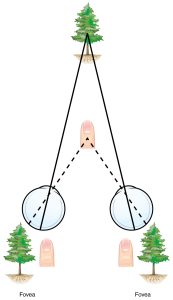Color, Depth, and Size
106
Learning Objectives
Be able to describe the concepts of disparity, vergence, and accommodation.
Understand what the horopter is.
Understand the disparity neurons in the primary visual cortex.
Stereo depth cues or binocular depth cues are when the photoreceptors or movements of both eyes are required for depth perception. Our ability to perceive spatial relationships in three dimensions is known as depth perception. With depth perception, we can describe things as being in front, behind, above, or to the side of other things. We use a variety of cues in our visual field to establish our sense of depth. Some of these are binocular cues are disparity, vergence, and accommodation. Binocular disparity is the slightly different view of the world that each of our eyes receives. Vergence refers to the equal movements of the eyes to a certain point. Accommodation refers to the focus of your eyes on distant or near objects.
Accommodation and vergence usually match—your eyes are verged and focused on the thing you’re looking at, and that point defines the horopter. The horopter is an imaginary circle drawn through the point where the eyes are converged on and back to the eyes, which traces out the location of all objects in the three-dimensional visual field that will land on the retinae with zero disparity. Things that are closer to you than the horopter have negative (crossed) disparity and things beyond the horopter have positive disparity. In the primary visual cortex (V1), disparity neurons are tuned to the general area of images of a similar object on every retina. Some neurons are tuned to near; some to far.

In this video, you can learn more about how accommodation works.
OpenStax, Psychology Revisions Chapter 27 Vision
Provided by: Rice University.
URL: https://opentext.wsu.edu/ospsychrevisions/chapter/vision/
License: CC BY 4.0
Adapted by: Lucas Gaffney
Cheryl Olman PSY 3031 Detailed Outline
Provided by: University of Minnesota
Download for free at http://vision.psych.umn.edu/users/caolman/courses/PSY3031/
License of original source: CC Attribution 4.0
Adapted by: Lucas Gaffney

